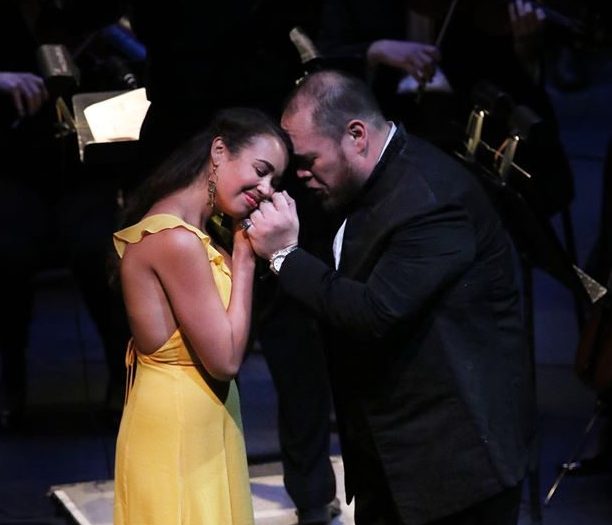
The Star-Advertiser Review – Spectacular ‘Rigoletto’ benefits from concert format
Sunday’s concert performance of Verdi’s “Rigoletto” marked a first for both Hawaii and Hawaii Opera Theatre, which has built its 55-year reputation on fully staged operas.
At first blush, a concert production lacking sets and costumes may seem somehow “less” than a fully staged production, but HOT’s performance was such a resounding success, it revealed unexpected advantages.
The concert format focused attention on the story as told through the music – the entire point of opera.
HOT’s was not the typical concert rendition in which soloists sing in place from behind their music stands. In this production, singers were “off book” and acted their roles fully, lending an immediacy that was as powerful as, and in some ways even more powerful than, a staged production. Without visual effects, both music and imagination leapt to the fore, becoming more vivid.
Most importantly, voices matched their roles to a degree that’s difficult to achieve when singers’ ages, heights and bodies matter for staging.
The big draw for many in the audience was Quinn Kelsey, the now renowned baritone born and raised in Hawaii, on stage with John Mount, his voice teacher from “back in the day” at the University of Hawaii at Manoa.
Kelsey has a large and loyal following: Blaisdell was packed full, and the line for will-call tickets wrapped around the building, delaying the start.
“Rigoletto” has become something of a signature role for Kelsey, whose large, rich baritone has the power and nuance to convey the demanding role’s wide range of emotions.
The story is the tragedy of Rigoletto, a hunchbacked court jester serving the womanizing Duke of Mantua. When Rigoletto mocks Monterone, a man whose daughter has been ravaged by the Duke, Monterone curses the Duke and Rigoletto. The rest of the opera is the unfolding of that curse (the opera was originally named “La maledizione,” or “The Curse”): The Duke seduces Rigoletto’s daughter, Gilda, who ends up dying to save the Duke’s life.
Kelsey’s highlights included his touching duet with Gilda (Nadine Sierra), and his portrayal of a father’s anguish as he tries to find out what has happened to his missing daughter. It was a knockout performance, and he is clearly at the height of what will surely be a long and storied vocal career. Let’s hope HOT brings Kelsey back regularly to perform for his hometown fans.
The evening’s surprise was all the other outstanding leads.
Sierra’s spectacular Gilda was a perfect a match between singer and role. She has sung the role for La Scala and the Metropolitan Opera. The role is so challenging it is usually sung by mature singers in their 40s. Sierra is, unbelievably, still in her 20s, and is, quite believably, the youngest singer ever to win the Metropolitan Opera National Council Auditions and the Marilyn Horne Foundation Vocal Competition.
Sierra’s voice is already very large and presumably still growing, with a clarity and purity of tone rare in large voices. Hers is a lyric soprano with the highest of high notes and a marvelously wide dynamic range. Her “Caro nome” aria was met with a well-earned storm of applause.
Barry Banks, as the womanizing Duke of Mantua, was another great vocal match and the quintessential Verdian tenor: high notes, warm tone and the power to deliver. His rendition of “Rigoletto’s” iconic ironic aria, “La donna e mobile” (“Woman is fickle,” in which the fickle Duke is oblivious to Gilda’s steadfast love) was terrific.
Matthew Trevino was a dashingly dark assassin, Sparafucile, his long, low note a muted threat as he slowly exited. And Cynthia Hanna was both comically beguiling yet endearing as Maddalena, Sparafucile’s sister who seduces the Duke while Gilda watches.
Notable local singers included a strong male chorus, John Mount as Monterone, a trio of courtiers — Buz Tennent, Erik Haines and Kip Wilborn — and even Kelsey’s sister, Blythe Kelsey, as Giovanna, Gilda’s maid.
Casting made the production click: The powerhouse voices represented faithful, steadfast and pure love; the beguiling voices — fickle and false, assassins and seductresses — were powerful but in the end overpowered by purity.
In another first for opera in Hawaii, the orchestra was seated on stage, between chorus and soloists, which made balancing orchestra and soloists in climaxes challenging, but which also resulted in a more integrated sound, punctuated by brilliant solos, such as Lance Suzuki’s flashes of lightning on piccolo.
HOT’s “Rigoletto” was not staged, but sets and costumes were nonetheless conjured by Sandy Sandelin’s lighting — deep blues for night, red for the curse, dappled green-blues for the garden, flashes of white for lightning — and by the singers’ concert dress — a canary-yellow gown for Gilda, the sunshine of Rigoletto’s life, a black lacy, spaghetti-strapped, bustier gown for the seductress Maddalena, and dusky red for Countess Ceprano, the object of the Duke’s lust.
The success of this HOT production suggests opera in concert may have a future in Hawaii. It’s a popular format in cities elsewhere, mostly Europe and some on the mainland, and if this is a way to offer more productions per year or to bring in singers without the time in their schedules for a full production, let’s hope there will be more.
By Ruth Bingham, Special to The Honolulu Star-Advertiser
———
Concert production of “Rigoletto,” composer Giuseppe Verdi and librettist Francesco Maria Piave; conductor Hal France; rehearsal pianist/chorus co-director Beebe Freitas; chorus co-director Nola Nahulu; stage director Barett Hoover; lighting designer Sandy Sandelin; stage manager Kale Okazaki.
With Quinn Kelsey (Rigoletto); Nadine Sierra (Gilda); Barry Banks (Duke of Mantua); Matthew Trevino (Sparafucile); Cynthia Hanna (Maddalena); John Mount (Monterone); Buzz Tennent (Marullo); Kip Wilborn (Borsa); Erik D. Haines (Count Ceprano); Toby Newman (Countess Ceprano); Blythe Kelsey (Giovanna); Jacque Comer (Page); Keane Ishii (Herald).
